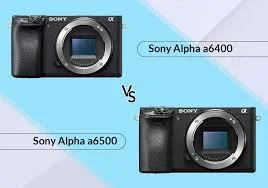When it comes to mirrorless cameras, Sony has established itself as a leading brand with a range of impressive models. Among their offerings, the Sony A6400 and A6500 stand out as popular choices for both amateur and professional photographers. This article provides a detailed comparison of the Sony A6400 vs A6500, examining their key features, performance, and which might be the better choice depending on your needs.
Overview of the Sony A6400 and A6500
Both the Sony A6400 and A6500 are part of Sony’s highly-regarded Alpha series of mirrorless cameras. Each model brings its own set of features and specifications, making them suitable for different types of users. Understanding the distinctions between these two models can help you make an informed decision.
Sony A6400
Released in January 2019, the Sony A6400 is known for its advanced autofocus system and robust video capabilities. It is often praised for its impressive speed and versatility, making it a strong contender for those who need a reliable and high-performing camera.
Sony A6500
The Sony A6500, introduced in November 2016, is known for its excellent image stabilization and superior build quality. It offers features that cater to both still photography and video recording, making it a popular choice among enthusiasts.
Key Specifications: Sony A6400 vs A6500
To better understand the differences between the Sony A6400 and A6500, let’s compare their key specifications:
Sensor and Image Quality
- Sony A6400: Features a 24.2 MP APS-C sensor with BIONZ X image processor. This combination ensures high-resolution images with excellent detail and color accuracy.
- Sony A6500: Equipped with a 24.2 MP APS-C sensor and the same BIONZ X processor, providing similar image quality in terms of resolution and color accuracy.
Autofocus System
- Sony A6400: Boasts a cutting-edge 425-point phase-detection autofocus (PDAF) and 425 contrast-detection points. It also includes Real-Time Eye autofocus for both humans and animals, which enhances portrait and wildlife photography.
- Sony A6500: Offers a 169-point phase-detection autofocus system combined with 425 contrast-detection points. While effective, it lacks the advanced Real-Time Eye autofocus found in the A6400.
Image Stabilization
- Sony A6400: Does not have in-body image stabilization (IBIS), relying on lens-based stabilization instead.
- Sony A6500: Includes 5-axis in-body image stabilization, which is beneficial for handheld shooting and video recording, particularly in low-light conditions.
Video Capabilities
- Sony A6400: Supports 4K video recording with full pixel readout and no pixel binning, which results in high-quality video with minimal noise and artifacts. It also features a 180-degree tilting touchscreen for easy vlogging and self-recording.
- Sony A6500: Also records 4K video, but with a slight crop. It does offer a 3-inch touchscreen and has a built-in headphone jack, which is a plus for serious video work.
Build and Design
- Sony A6400: Slightly lighter and more compact than the A6500, which makes it a more portable option. It features a weather-sealed body that offers some protection against dust and moisture.
- Sony A6500: Slightly bulkier but provides a more rugged build quality. It also has a higher-resolution viewfinder and better ergonomics for extended use.
Performance and Usability
Sony A6400
The Sony A6400 excels in autofocus performance and video capabilities, making it an excellent choice for dynamic shooting environments. Its advanced Real-Time Eye autofocus is particularly beneficial for portrait photographers and content creators. The tilting touchscreen is a useful feature for vloggers and those who need to capture selfies.
Sony A6500
The A6500’s in-body image stabilization makes it a strong contender for handheld shooting, especially in challenging lighting conditions. Its 5-axis stabilization system helps reduce camera shake, resulting in sharper images and smoother video. Although the A6500 lacks some of the advanced autofocus features of the A6400, its overall performance and build quality make it a solid choice for enthusiasts.
Conclusion
When comparing the Sony A6400 vs A6500, each camera has its strengths and ideal use cases. The A6400 is renowned for its superior autofocus system and video capabilities, making it a versatile choice for a range of photographic and videographic needs. On the other hand, the A6500’s in-body image stabilization and robust build quality cater to users who prioritize stability and durability.
Ultimately, the choice between the Sony A6400 and A6500 depends on your specific needs and preferences. If you require cutting-edge autofocus and superior video features, the A6400 may be the better option. However, if in-body image stabilization and a more rugged build are important to you, the A6500 could be the ideal choice.
Which camera, the Sony A6400 or A6500, aligns better with your photography or videography needs?










